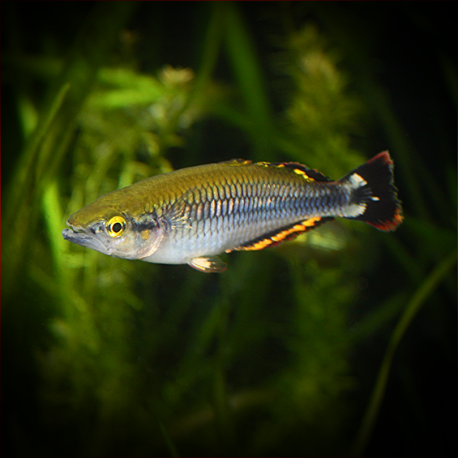More info
Datasheet
| Minimum Tank Size | 120 litres / 31.70 US gallons |
| Maximum Size | 10.0cm / 3.94inches |
| Temperature | 23°C / 73.40°F - 32°C / 89.60°F |
| Hardness | 0.00dgH / 0ppm - 15.02dgH / 268ppm |
| pH | 4.5-7.5 |
General Description
First imported for the aquarium hobby during the 1950s, the Madagascan Rainbow Fish (Bedotia Madagascarensis) is often confused with the Bedotia geayi species. Males of B. madagascarensis display distinctive black central caudal rays, surrounded by silvery white or golden yellow pigmentation enclosed by a dark band, with dark red or bright white fin tips. In comparison, B. geayi males have a red spot on the lower jaw and different morphometric measurements. The species showcases polymorphism in the wild, with variations in coloration patterns among individuals.
Aquarium Setup
To maintain Madagascan Rainbow Fish, a tank of at least 120 liters is recommended (see table). The species thrives in well-oxygenated water with high quality and prefers heavily planted setups with driftwood, roots, and branches. Weekly water changes of 30-50% are crucial, as the species is sensitive to organic waste buildup. Decorating the tank with surface vegetation and leaf litter enhances the natural habitat feel.
Behaviour
Madagascan Rainbow Fish are non-aggressive and best kept in schools of 8-10 specimens to reduce nervousness and enhance color displays in males competing for female attention. They make good tankmates with Australasian rainbowfishes, characids, and peaceful cichlids, but should be avoided with other Bedotia species due to the risk of hybridization. In a Madagascan community tank, they can serve as dither fish for endemic cichlids.
Feeding and Diet
Although generally unfussy eaters, Madagascan Rainbow Fish mainly consume terrestrial insects and invertebrates. Offer a varied diet of small live and frozen foods such as bloodworms, Daphnia, and Artemia, alongside high-quality dried flakes and granules. Providing live foods is essential if breeding is a goal.
Reproduction & Dimorphism
For breeding, Madagascan Rainbow Fish deposit eggs in vegetation or substrate. Spawning in pairs or small groups is recommended, with females capable of laying several eggs daily. Males can display aggression towards females during breeding, requiring monitoring. Adult males exhibit more ornate pigmentation in the fins compared to females, with females displaying a fuller body when gravid.
Habitat and Distribution
Madagascan Rainbow Fish inhabit clear, flowing streams with soft freshwater and prefer shaded areas along riparian vegetation. They are native to eastern Madagascar, found in small streams and lower reaches of rivers draining into coastal lagoons and lakes. The species' distribution extends from the lower Ivoloina River to south of the town of Vatomandry, with varying species replacing it in other regions of Madagascar.

